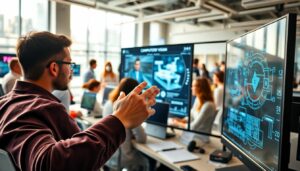Have you ever wondered how computers “see” the world the way humans do? Computer vision and image processing are instrumental in making that a reality.” Both deal with how technology interprets images, but they are not interchangeable. This article will help you understand the differences and similarities of both these fields. It aims to clarify how they work and the role that each plays.
Defining Image Processing
Now, first lets move to image handling. Image processing can be seen as the base of this process.
What is Image Processing?
So essentially image processing is simply editing images to get them improved. Its most notable improvement is in the image quality. The method operates by revising the pixels within an image. With it, you can sharpen, brighten or tint colors in an image.
These techniques focus on interacting with the image data directly.
Popular Techniques in Image Processing
There are various techniques of image processing. Some of these include filtering, noise reduction, and edge detection. You can filter to smooth an image or enhance certain features. Noise reduction cleans up grainy or blurry pictures. Use Edge detection find the contours of objects in an image. Think of Instagram filters you put on your phone to enhance photos. That’s how image processing works.
There are many fields that use image processing. Its applied to medical imaging, too, to enhance X-rays and MRIs. Satellite imagery employs it to sharpen images of Earth. Editing software uses it to improve your snapshots. These operations are also applied on old photographs to recover them.
Defining Computer Vision
Now, want to go into computer vision. It’s a step beyond processing images.
What is Computer Vision?
Computer vision is when computers can ”see” and understand images. Its goal is to replicate human vision. It applies algorithms and models to understand what is inside of an image. A computer can identify faces, objects, or scenes. You could think of it as helping machines understand what they see.
Main elements of computer vision systems
Computer vision is comprised of the following several stages. First, images are captured. After that, pre-processing processes the image so that it is in good shape. Then, feature extraction extracts key elements. Interpretation is the final step on helping the computer understand the image. With the help of this entire process, machines will be able to take decisions based on visual data.
Computer Vision in Real World Applications
Know that in many fields, the use of the computer vision. It’s what self-driving cars use to navigate roads. Facial recognition systems open phones and guard buildings. Manufacturing plants employ it to identify defects in products. It’s transforming how machines experience the world.
What Is the Difference Between Computer Vision and Image Processing?
Here’s the thing: image processing and computer vision are not quite the same. These distinctions are often forgotten, but knowing these distinctions is critical.
Level of Abstraction
Limitations: Image processing is a low-level operation. It works by optimizing pixels. Natural language processing handles structural representation. It attempts to read the meaning of an image. Image processing adds clarity; computer vision brings understanding.
Input and Output
So, like any other image processing, it takes an image as input. It generates an altered image as an output. When we look at it, the computer vision takes an image as input. It can produce labels, classifications, or decisions. The data that gets pumped back and forth between them serves different purposes.
Goals and Objectives
One of the goal of image processing is image enhancement. It improves the look of images for human audiences. The ultimate goal of computer vision is the understanding of images. It makes it possible for computers to understand visual data. Processing is aimed at making a good photo. Vision is one agent whose goal is useful data.
Overlap and Synergy
There is in fact a lot of overlap between these fields. Computer vision is often aided by image processing.
A Brief History of Computer Vision: Image Processing
Computer vision can analyze images after image processing cleans them up. If you reduce noise, for example, object detection can work better. It is an important first step in that process.
Integrated Systems
There are systems that employ both image processing and computer vision together. Diagnostic systems can improve, say, a MRI imagery. They then apply computer vision algorithms to identify tumors. These are embedded systems that offer strong solutions.
Future Trends and Innovations
Image processing and computer vision are both similar fast-growing domains. Two are being aided by emerging technologies.
Advancements in Deep Learning
These fields are being transformed by deep learning. This enables more advanced image analysis and enhancement. CNN is being widely used to solve image recognition and image processing problems. This is enhancing automation.
The intersection of vision and AI
Artificial intelligence makes advances in image processors and computer vision. More advanced image comprehension through AI algorithms. However, this trend promises many future applications.
Conclusion
Computer vision and image processing are related but different fields. Computer vision is centered around understanding images, whereas image processing is centered around improving the quality of the image. Image processing example as pre-processing for computer vision This knowledge is significant for image specialists. Both fields are rapidly evolving. And they are only expected to have an even greater impact on tech going forward.



